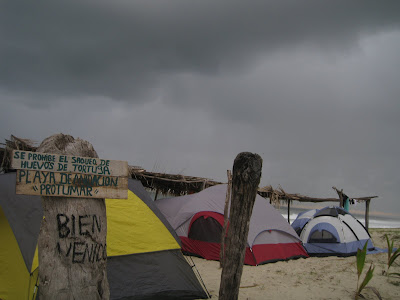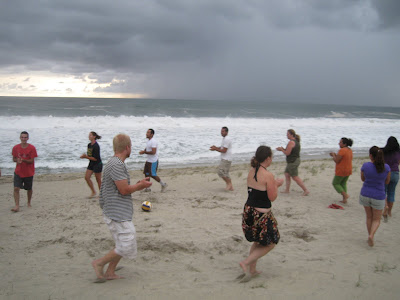SATURDAY EVENING, AUGUST 21st
EL VENADO: Beach Camping and Turtle Hatchery
After-work adventures entailed a trip out to the beach near the Esperanza community of El Venado for a night of camping with the community members.


An 11 year-old girl from El Venado talked with us about the salt production process that she and her family partake in as a means of income. She has been working in this process since she was 6 years old, helping collect the salt-infused soil from which the salt is extracted through a rudimentary distillation process. We had hoped to join in on the process, but due to it being rainy season here on the coast of Oaxaca, it is not possible to do so during this part of the year. Future volunteer groups that are here during January and February will have the opportunity to partake in this unique opportunity!
 Our group circling around in anticipation of the salt production presentation.
Our group circling around in anticipation of the salt production presentation. Dan partaking in much deserved down-time.
Dan partaking in much deserved down-time. Erin doing the same.
Erin doing the same. Before dinner, we were joined by elders of the El Venado community who have taken it upon themselves to become caretakers of the sea turtles in this region. Sea turtles will come to this 3 mile stretch of coastline to lay anywhere from 60 to 200 eggs beneath the sand in a once-in-a-lifetime birthing ritual. The turtle will never meet its offspring, for once it lays its eggs, it will return to the sea. While the sea turtle population here once thrived, the numbers have since plummeted, due in part to the `coyotes` i.e. people that stalk the beach to steal a turtle´s eggs right after they are laid. Turtle eggs are a delicacy, so many times the `coyotes`are locals stealing the eggs for their restaurants. The elders of the El Venado community have set up a guarded hatchery for the turtle eggs. Four times a night, at 10pm, 12am, 2am and 4am, volunteers from the community set out on foot in pairs to cover the 3 mile stretch of coastline tracking signs of turtles that have just laid their eggs. When they find fresh tracks, they dig down and retrieve the eggs, bringing them back to the hatchery. At the hatchery, each set of eggs is buried together, deep beneath the sand, and marked with the date they were laid. Approximately 45 days later, the eggs will hatch and the baby turtles will make their way out to sea. The task of protecting turtles can be a dangerous one, as these caretakers have been threatened many times by coyotes they encounter during their nightly searches.
Before dinner, we were joined by elders of the El Venado community who have taken it upon themselves to become caretakers of the sea turtles in this region. Sea turtles will come to this 3 mile stretch of coastline to lay anywhere from 60 to 200 eggs beneath the sand in a once-in-a-lifetime birthing ritual. The turtle will never meet its offspring, for once it lays its eggs, it will return to the sea. While the sea turtle population here once thrived, the numbers have since plummeted, due in part to the `coyotes` i.e. people that stalk the beach to steal a turtle´s eggs right after they are laid. Turtle eggs are a delicacy, so many times the `coyotes`are locals stealing the eggs for their restaurants. The elders of the El Venado community have set up a guarded hatchery for the turtle eggs. Four times a night, at 10pm, 12am, 2am and 4am, volunteers from the community set out on foot in pairs to cover the 3 mile stretch of coastline tracking signs of turtles that have just laid their eggs. When they find fresh tracks, they dig down and retrieve the eggs, bringing them back to the hatchery. At the hatchery, each set of eggs is buried together, deep beneath the sand, and marked with the date they were laid. Approximately 45 days later, the eggs will hatch and the baby turtles will make their way out to sea. The task of protecting turtles can be a dangerous one, as these caretakers have been threatened many times by coyotes they encounter during their nightly searches. El Venado Turtle hatchery.
El Venado Turtle hatchery. El Venado elders discussing their turtle hatchery.
El Venado elders discussing their turtle hatchery. Each wooden post in the sand marks a batch of turtle eggs that have been retrieved and are awaiting the time of hatching.
Each wooden post in the sand marks a batch of turtle eggs that have been retrieved and are awaiting the time of hatching.
We had the opportunity to join one of the elders on a midnight search for turtles. He led the way with his machete at a quick pace as we followed the coastline 1.5 kilometers toward a distant mountain. The moon was nearly full and we were able to see without lights, though we carried them with us. The 3 kilometer round-trip adventure took several hours, as trekking through the sand is not easy. I was humbled at the thought of the El Venado members volunteering their time to make this trek every night, four times a night, during egg-laying season. Right now is NOT egg laying season, so we had been forewarned that the likelihood of actually finding turtle eggs was extremely small. Sure enough, during our trek we saw one sign of a turtle, but no eggs had been laid.
Upon our disappointed arrival back to our campsite and the location of the turtle hatchery, within 5 minutes there was a hollering from the beach in front of our tents. A turtle had made its way to our very campsite and had begun its ritual of laying eggs!! A group of us gathered around the backside of the turtle, between it and the ocean, as the elders carefully moved the sand to the side, giving us a view of the egg laying process. The elders informed us that during this once-in-a-lifetime ritual, the turtle goes into a trance during the actual egg laying and thus is not aware of our presence. After the eggs are laid, the turtle packs the sand around the eggs and during this part of the ritual, tears can be seen falling from its eyes. We stood in awe and wonder as witnesses to this sacred event.
The turtle we observed laid 91 eggs!




No comments:
Post a Comment